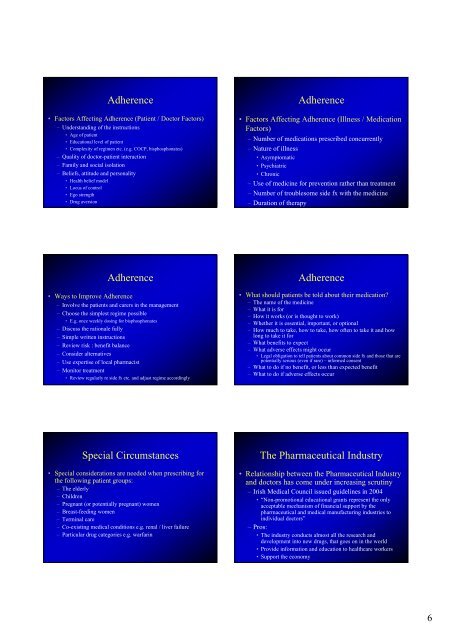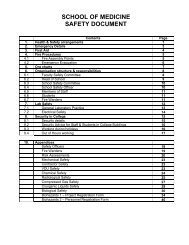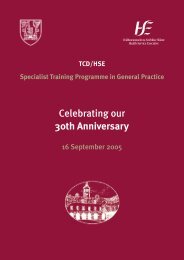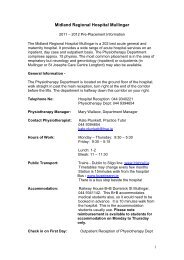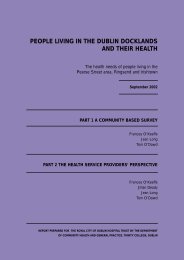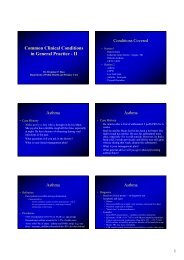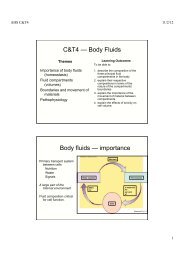Prescribing in General Practice
Prescribing in General Practice
Prescribing in General Practice
Create successful ePaper yourself
Turn your PDF publications into a flip-book with our unique Google optimized e-Paper software.
Adherence<br />
• Factors Affect<strong>in</strong>g Adherence (Patient / Doctor Factors)<br />
– Understand<strong>in</strong>g of the <strong>in</strong>structions<br />
• Age of patient<br />
• Educational level of patient<br />
• Complexity of regimen etc. (e.g. COCP, bisphosphonates)<br />
– Quality of doctor-patient <strong>in</strong>teraction<br />
– Family and social isolation<br />
– Beliefs, attitude and personality<br />
• Health belief model<br />
• Locus of control<br />
• Ego strength<br />
• Drug aversion<br />
Adherence<br />
• Factors Affect<strong>in</strong>g Adherence (Illness / Medication<br />
Factors)<br />
– Number of medications prescribed concurrently<br />
– Nature of illness<br />
• Asymptomatic<br />
• Psychiatric<br />
• Chronic<br />
– Use of medic<strong>in</strong>e for prevention rather than treatment<br />
– Number of troublesome side fx with the medic<strong>in</strong>e<br />
– Duration of therapy<br />
Adherence<br />
• Ways to Improve Adherence<br />
– Involve the patients and carers <strong>in</strong> the management<br />
– Choose the simplest regime possible<br />
• E.g. once weekly dos<strong>in</strong>g for bisphosphonates<br />
– Discuss the rationale fully<br />
– Simple written <strong>in</strong>structions<br />
– Review risk : benefit balance<br />
– Consider alternatives<br />
– Use expertise of local pharmacist<br />
– Monitor treatment<br />
• Review regularly re side fx etc. and adjust regime accord<strong>in</strong>gly<br />
Adherence<br />
• What should patients be told about their medication<br />
– The name of the medic<strong>in</strong>e<br />
– What it is for<br />
– How it works (or is thought to work)<br />
– Whether it is essential, important, or optional<br />
– How much to take, how to take, how often to take it and how<br />
long to take it for<br />
– What benefits to expect<br />
– What adverse effects might occur<br />
• Legal obligation to tell patients about common side fx and those that are<br />
potentially serious (even if rare) – <strong>in</strong>formed consent<br />
– What to do if no benefit, or less than expected benefit<br />
– What to do if adverse effects occur<br />
Special Circumstances<br />
• Special considerations are needed when prescrib<strong>in</strong>g for<br />
the follow<strong>in</strong>g patient groups:<br />
– The elderly<br />
– Children<br />
– Pregnant (or potentially pregnant) women<br />
– Breast-feed<strong>in</strong>g women<br />
– Term<strong>in</strong>al care<br />
– Co-exist<strong>in</strong>g medical conditions e.g. renal / liver failure<br />
– Particular drug categories e.g. warfar<strong>in</strong><br />
The Pharmaceutical Industry<br />
• Relationship between the Pharmaceutical Industry<br />
and doctors has come under <strong>in</strong>creas<strong>in</strong>g scrut<strong>in</strong>y<br />
– Irish Medical Council issued guidel<strong>in</strong>es <strong>in</strong> 2004<br />
• “Non-promotional educational grants represent the only<br />
acceptable mechanism of f<strong>in</strong>ancial support by the<br />
pharmaceutical and medical manufactur<strong>in</strong>g <strong>in</strong>dustries to<br />
<strong>in</strong>dividual doctors”<br />
– Pros:<br />
• The <strong>in</strong>dustry conducts almost all the research and<br />
development <strong>in</strong>to new drugs, that goes on <strong>in</strong> the world<br />
• Provide <strong>in</strong>formation and education to healthcare workers<br />
• Support the economy<br />
6


